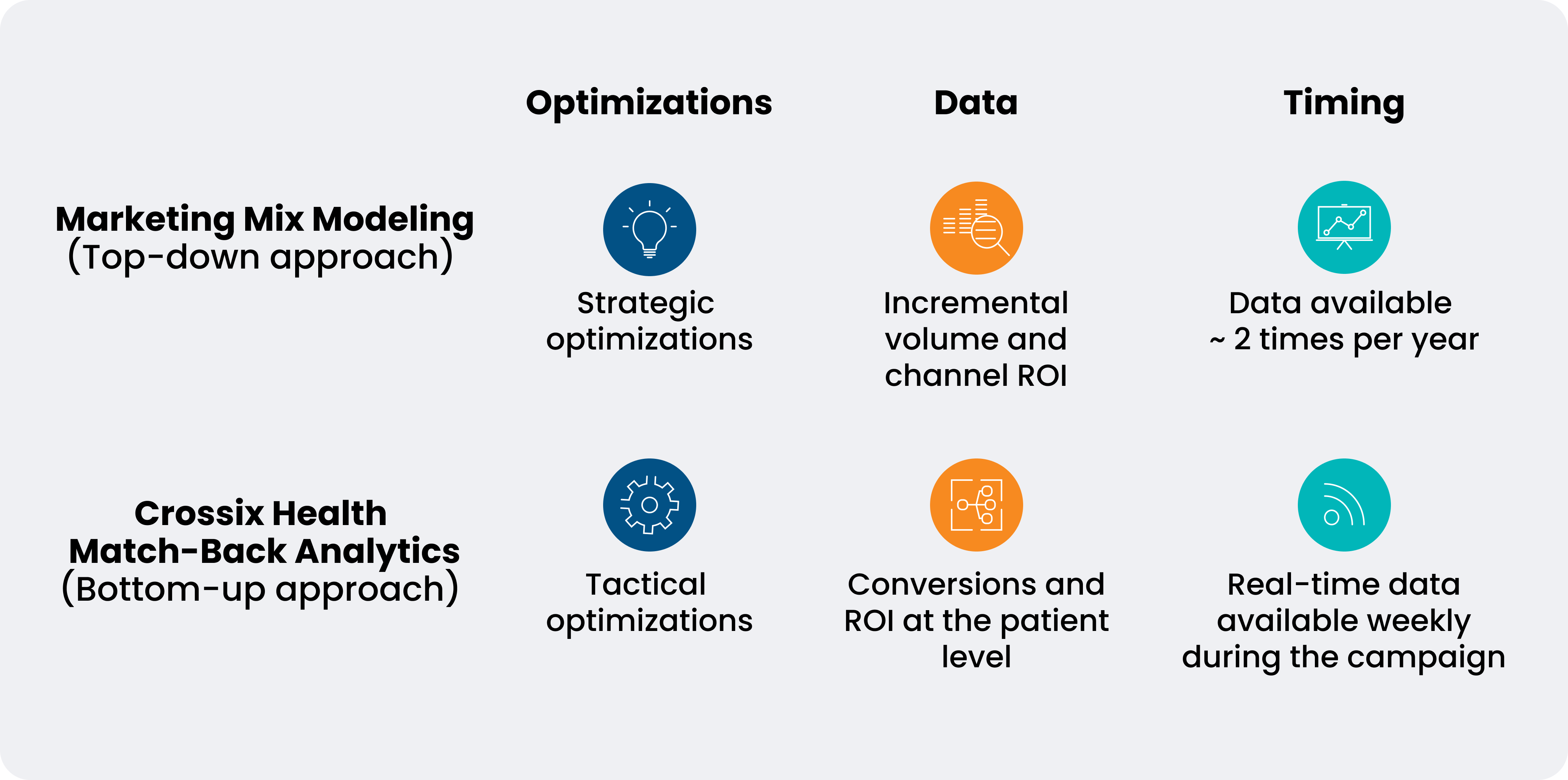Article
GSK: Improving Marketing Performance with the Right Combination of Data
“We’re using the combined advantages of marketing mix modeling and marketing analytics from Veeva Crossix to get the optimal amount of spend and media mix and to maximize our ROI,” says Alberto GarciaTuñón, director of digital media and analytics capabilities at GSK. While each framework serves a specific purpose, leveraging the strengths of each in a unified approach to marketing planning, strategy, and optimizations is helping GarciaTuñón and his team make more informed decisions, leading to improved performance.
Comparing top-down and bottom-up analytics approaches
Marketing mix modeling is a top-down framework that quantifies impact using time series promotional data and outcomes at a high level. It helps predict the drivers of your business, the ROI on your investment, and where there are opportunities to make strategic allocation changes. “For GSK, this means getting the optimal media mix to generate scripts and vaccines to maximize profitability,” says GarciaTuñón.
Crossix provides observational analytics — or match-back analytics — and is a bottom-up approach. This is a different framework that relies on directly connecting who saw an ad and matching that information back to health data in a privacy-safe way, providing a granular understanding of media effectiveness.

How to leverage strengths from each approach
At GSK, marketing mix modeling helps GarciaTuñón and his team make strategic optimizations. “We can determine for each dollar that you increase in each channel — for instance, linear TV, paid search, and paid social — that the result will be an increase in prescriptions or vaccinations,” he says.
However, GarciaTuñón emphasizes the importance of granular, patient-centric data for his team. “We’re in the business of patients,” he says. “And marketing mix is not tied to patients.” For example, with Crossix data, his team can compare patients who saw an ad and then filled a prescription to patients who didn’t see an ad and also filled a prescription. “The difference between those is lift,” he says. “This shows us the economic impact of our media.”
GarciaTuñón also points to a crucial benefit of observational analytics — timely data. “Crossix can give us responses in real-time once conversion data is available, which can be as early as 4-6 weeks,” he says. “But with marketing mix modeling, the data for those predictors is only as of a given date.”
This type of real-time data can help ensure that patients who see the ads can benefit from the therapy. If a vaccine is indicated for a 50+ audience, but data in Crossix shows that only young, healthy adults without relevant conditions are seeing the ads, the media will not have much impact. You can then use patient-centric data to make tactical optimizations that can improve performance and reduce media waste.
In other instances, Crossix data might also help answer questions about interactions across the overall marketing plan to better understand the patient journey. You could look at how many people saw an ad on linear TV and then went to the brand website within a month, saw a display ad in another two weeks, and then went to the doctor. Linking those data sets together can help you identify overlap and synergies between different channels.
Making the right data combinations
All top 20 life sciences organizations now conduct both marketing mix modeling and observational analytics, yet many utilize them in silos. Using them together, like at GSK, can provide you with valuable information to make strategic and tactical decisions. “We consider all options for data,” says GarciaTuñón. His team is constantly testing with marketing mix modeling to see what kind of results they will get. “But there are limitations with the marketing mix modeling alone, so we integrate it with an optimization model using Crossix data.”
For instance, when you look at vaccinations, there are many paths that patients can take. “With Crossix, we can see who saw an ad and went to see a doctor,” he says.“We can also see who saw an ad and went to a pharmacy. So it not only shows us the lift for people getting the doses but also where they went for care."
Getting the most out of your data
When looking to improve marketing performance, how should you be thinking about marketing mix modeling and observational analytics? Understand and utilize the strengths of each so you can identify opportunities where they can work together. Make sure you have a framework that provides the right type of data so you can actively optimize during campaigns and at key strategic decision points. When you go into major events like annual planning and quarterly upfronts, bring your big-picture data for major allocation choices and tactical insights for more in-flight decisions.
Learn more about the benefits of actionable real-time marketing analytics to improve campaign performance.